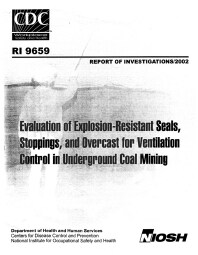Mining Publication: Evaluation of Explosion-Resistant Seals, Stoppings, and Overcast for Ventilation Control in Underground Coal Mining
Original creation date: December 2002
Authors: ES Weiss, KL Cashdollar, MJ Sapko
NIOSHTIC2 Number: 20022271
Pittsburgh, PA: U.S. Department of Health and Human Services, Public Health Service, Centers for Disease Control and Prevention, National Institute for Occupational Safety and Health, DHHS (NIOSH) Publication No. 2003-104, Report of Investigations 9659, 2002; Dec :1-48
A fundamental safety research area for the National Institute for Occupational Safety and Health (NIOSH) is to eliminate the occurrence of coal mine explosions or to mitigate their effects. One approach is to develop and evaluate new and innovative seal designs that provide increased explosion protection for mining personnel. The NIOSH Pittsburgh Research Laboratory (PRL) cooperated with HeiTech Corp. of Virginia, Barclay Mowlem Construction Ltd. of Queensland, Australia, and the Mine Safety and Health Administration (MSHA) in three separate research programs to evaluate the strength characteristics and air leakage resistance of numerous innovative seal designs and ventilation control structures for use in underground coal mines. For each phase of the program, various full-scale seals, stoppings, and an overcast design were constructed in PRL's Lake Lynn Experimental Mine near Fairchance, Fayette County, Pennsylvania. The seals and stoppings were built in crosscuts and were subjected to explosions to evaluate their strengths. Four pumpable cementitious seal designs ranging in thickness from 610 to 915 mm (24 to 36 in) were evaluated in the first cost-reimbursable research program with HeiTech Corp. A simple wooden framework with brattice liner was used as a form to contain the cementitious slurry during the curing period. As the seal designs decreased in thickness, higher compressive strength cementitious grout was used. All four seals withstood an explosion pressure pulse of at least 138 kPa (20 psi) while maintaining acceptable air leakage resistance. In the second cost-reimbursable research program with Barclay Mowlem Construction Ltd. of Australia, several innovative seal and stopping designs and an overcast design were evaluated. Each of the seal designs and the overcast side and wing walls used one or more air-inflated vinyl bladder assemblies anchored to the mine roof and hitched into the ribs and floor. The air within these bladders was displaced with a high-strength cementitious grout. The overcast deck consisted of a 200-mm (7 .8-in) thick reinforced cementitious slab. This was the first time that an overcast structure had been explosion tested under full-scale conditions. All of the seals, stoppings, and overcast design passed the air leakage tests before being subjected to a series of explosions with static pressure pulses ranging from 14 to 475 kPa (2 to 69 psi). Instrumentation measured seal and overcast wall displacement as a function of time. The 450-mm (17. 7-in) thick seal in the 2.8-m (9-ft) high third crosscut withstood an explosion pressure of 170 kPa (25 psi), but failed during a later test, which generated a peak static pressure of 475 kPa (69 psi) at the seal location. A similar 450-mm-thick seal in the 2.l-m (7-ft) high second crosscut withstood three explosion tests, which generated peak static pressures of 195, 205, and 370 kPa (28, 30, and 54 psi) at the seal location. Next, the overcast design withstood four explosions, which generated static overpressures ranging from 16 to 47 kPa (2.3 to 6.8 psi). A third program at the request of MSHA evaluated the effectiveness of using pressurized grout bags (Packsetter bags) along the mine roof and ribs in lieu of floor and rib hitching for a standard-type solid- concrete-block seal. This program was initiated to address an unusual geological mining condition encountered when building seals in entries where required rib hitching is not a viable option due to soft friable coal. Results showed that the use of these quick-setting grout-filled Packsetter bags pressurized internally to 300 kPa (44 psi) not only provides a seal that can withstand a l38-kPa static pressure explosion, but also provides a sealing option where rib hitching is not possible.

NIOSHTIC2 Number: 20022271
Pittsburgh, PA: U.S. Department of Health and Human Services, Public Health Service, Centers for Disease Control and Prevention, National Institute for Occupational Safety and Health, DHHS (NIOSH) Publication No. 2003-104, Report of Investigations 9659, 2002; Dec :1-48
- Comparison of the Transverse Load Capacities of Various Block Ventilation Stoppings under Arch Loading Conditions
- Compendium of Structural Testing Data for 20-psi Coal Mine Seals
- Designs for Rapid in Situ Sealing
- Evaluation of Reinforced Cementitious Seals
- Experimental Mine and Laboratory Dust Explosion Research at NIOSH
- Explosion Pressure Design Criteria for New Seals in U.S. Coal Mines
- Methane-Air Detonation Experiments at NIOSH Lake Lynn Laboratory
- Progress Toward Improved Engineering of Seals and Sealed Areas of Coal Mines
- Technology News 490 - An Inexpensive Device for Monitoring Explosions in Sealed Areas of Underground Mines
- Use of Ground Penetrating Radar and Schmidt Hammer Tests to Determine the Structural Integrity of a Mine Seal